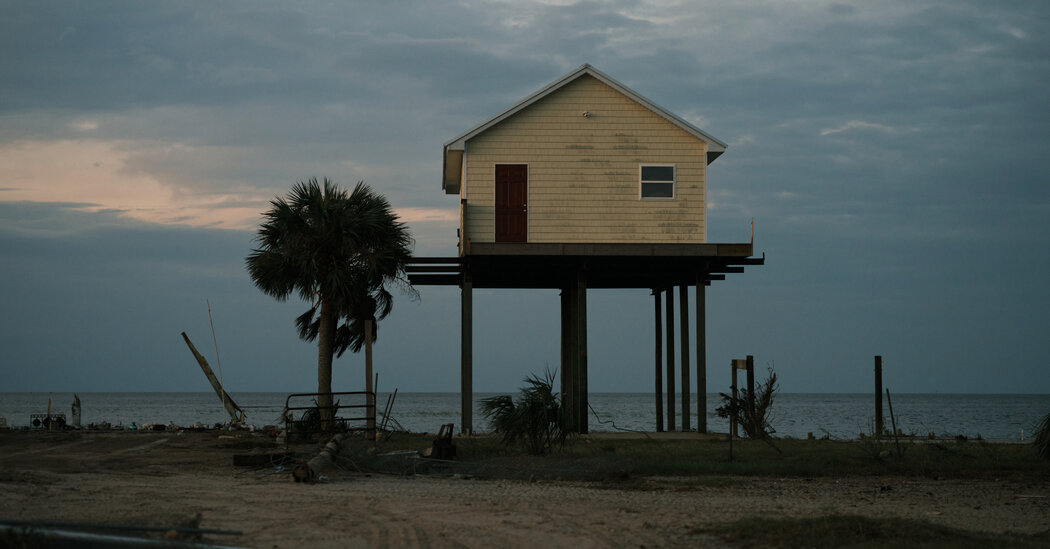It’s kind of a lot to live with a personal finance reporter like me. Everything is diversification and risk, prudent investing and delayed gratification.
So it was not a surprise a few years ago when my wife started asking open-ended questions about what constitutes smart real estate decision-making as the planet warms and the weather gets more severe.
She was right to ask. When the federal government alters its flood maps, it can affect your property values. Insurance companies want out of entire areas, in one fell swoop.
We live in Brooklyn, and I’d long wondered what a storm like 2012’s Hurricane Sandy, except three times as strong, would do to our city. We’re not on a flood-prone block, and the apartment we own is pretty well protected from the elements. But could (another) storm of the century render the city unlivable for months?
And there was another conundrum: Like many Americans, we’ve been lucky enough to own our dwelling for a while, as housing prices have largely risen. As a result, our home equity is a decent chunk of our net worth. We have a lot riding on this one home of ours. Too much, maybe.
Everything is diversification and risk, remember?
But in the wake of my wife’s questions, it wasn’t immediately apparent where else we should live — if not tomorrow, then someday soon, in some magic, climate-safe landing spot.
But nobody seemed to be rating or ranking communities according to whether there was going to be enough water or how hot it might get or where the floods and fires could come next.
A lack of resources
As someone who tries to be useful, above all else, for a living, it gnawed at me. Then this year, the fires arrived in Los Angeles. As soon as the extent of the devastation became clear, my colleague Tara Siegel Bernard and I went to work on a guide to climate-safe home shopping that we published this week. You can use it to assess your own home or community’s current risk, too.
My reporting partner Tara rents her Brooklyn abode, which may ultimately be the smartest long-term play. Maybe letting a landlord assume most of one’s personal climate exposure is the right move.
Still, Tara does spend her off hours online seeking a climate-friendly getaway that she and her family can call their own. So we started flinging questions at each other and some of the country’s best experts. We eventually addressed about 65 of them in our guide, which will lead you to resources that can help you find 65 answers in your chosen community.
Some of the things that came up were these queries: Will your insurance company cover mudslides? And how best to assess the muddied finances of the fast-growing state-owned insurance providers? In California and Florida, these entities were meant as a last resort, an insurance carrier that state residents could use when no commercial provider would underwrite a residential property. Now, they’re enormous — and vulnerable — in their own right.
As climate change upends state insurance markets, politics are in play, too. While it’s cheeky to wonder aloud when Gov. Ron DeSantis will need a statewide income tax to backstop the home insurance industry in Florida, it’s often local politicians who control the street-by-street work that can save your home, or not. What are their priorities, exactly?
What you can do
What about “micro-hardening” that can make your home more resistant to weather — the roof replacement, the landscaping, the new garage door? Evidence of climate consciousness can be right there in the real estate listings. We created the guide to help you figure out who has done what to their homes. So many places are soft, easy prey for ever-worsening weather.
But not all homes, and not all places. I’ve long fantasized about buying one of the 10,000 lakes in Minnesota and selling the surrounding parcels to my favorite people. There’s a fair bit of hail up there though, according to the FEMA maps that ought to be your starting point for research, for as long as the current administration in Washington keeps them up. Overall, Maine and western Massachusetts look promising, too.
Your risk tolerance may be different from mine. And yes, I know, another primary rule of personal finance is that a home is not an investment. But home equity is an asset. Millions of Americans’ balance sheets have concentrated risk.
Mine is one of them. This guide is a gift to myself — and anyone else who wants to sleep better at night, in a town or country that is as resilient as possible.
Read the full article.
Climate law
The $660 million Greenpeace verdict: what happens next?
Yesterday, I reported that Greenpeace has to pay more than $660 million to the company that built the Dakota Access Pipeline. That was the verdict from a jury in Mandan, N.D., after a three-week trial in a lawsuit brought by Energy Transfer, which had sued Greenpeace over its role in the Dakota Access Pipeline protests a decade ago.
Greenpeace was facing claims including trespass, defamation and conspiracy.
The sum was a shock to Greenpeace supporters. Rebecca Brown, president of the Center for International Environmental Law, called the case a “textbook example of corporate weaponization of the legal system to silence protest and intimidate communities.”
Energy Transfer’s lead lawyer, Trey Cox of Gibson, Dunn & Crutcher, celebrated the verdict as vindication for law enforcement officers who responded to the protests and for the local community. The protests took place about 45 minutes south of the courthouse, in and around the Standing Rock Indian Reservation.
Here are a couple of questions I’m still looking at:
Could the verdict be overturned?
There were three Greenpeace entities named in the suit: Greenpeace Inc. and Greenpeace Fund, which operate as Greenpeace USA, and then Greenpeace International, which is based in Amsterdam. Greenpeace USA had been warning that a $300 million verdict could put it out of business. The jury found them liable for roughly $530 million.
The exact figures still have to be finalized by the judge, according to Greenpeace, which says it will appeal the verdict to the North Dakota Supreme Court, where it could be overturned.
Yesterday outside the courthouse, the prominent First Amendment lawyer Martin Garbus, who was observing the trial, told me that he was concerned that an appeal that went all the way to the U.S. Supreme Court could be used “to eradicate” the landmark 1964 case New York Times v. Sullivan, which strengthened free-speech protections.
What’s the effect on other protest groups?
Greenpeace and its supporters say the case will have a chilling effect on future protests. It maintained that it played only a supporting role in demonstrations led by the Standing Rock Sioux Tribe.
The lead lawyer for Greenpeace, Everett Jack Jr., argued that Energy Transfer was trying to hold his client responsible for everything that happened during months of raucous encampments attended by thousands of people.
Greenpeace may have been an easy target because of its name recognition and relatively large budget. But smaller activist groups would not have the resources to fight such a case in court.— Karen Zraick
renewable energy
Clean energy, as seen from outer space
A new analysis shared with The New York Times shows how countries around the world are rapidly adding solar and wind capacity, now cheaper and more reliable than ever.
To track these changes, researchers created Global Renewables Watch, which maps all onshore wind and large-scale solar farms in the world by using artificial intelligence and detailed satellite imagery to create a “living atlas.”
The collaboration is designed to track the spread of wind and solar over time, so that planners can better understand where and how to build new clean-energy projects, large and small. — Mira Rojanasakul
Read the full article.
Climate data
Earth’s 10 Hottest Years on Record Are the Last 10
With the addition of 2024, yet another record-hot year, the past 10 years have been the 10 hottest in nearly 200 years of record-keeping, the World Meteorological Organization reports.
“That’s never happened before,” said Chris Hewitt, the director of the W.M.O.’s climate services division. It is the first time since record-keeping began that all of the 10 hottest years have fallen within the most recent decade. — Delger Erdenesanaa
Read the full article.
More climate news:
-
Off the coast of Antarctica, a gigantic iceberg about 19 miles long cracked off the ice sheet in January, revealing a swath of ocean that had not seen daylight in decades, The Washington Post reports. Underneath were giant sea spiders, octopuses, ice fish, corals and sponges.
-
President Trump will sign an executive order “that seeks to shift responsibility for disaster preparations to state and local governments, deepening his drive to overhaul the Federal Emergency Management Agency,” Reuters reports.
-
Also from Reuters: Amazon will begin selling carbon credits to its suppliers, business customers and other companies.
-
Heatmap News explores why BYD, the Chinese automaker, keeps shocking the world with its technology.
Thanks for being a subscriber.
Read past editions of the newsletter here.
If you’re enjoying what you’re reading, please consider recommending it to others. They can sign up here. Browse all of our subscriber-only newsletters here. And follow The New York Times on Instagram, Threads, Facebook and TikTok at @nytimes.
Reach us at climateforward@nytimes.com. We read every message, and reply to many!


